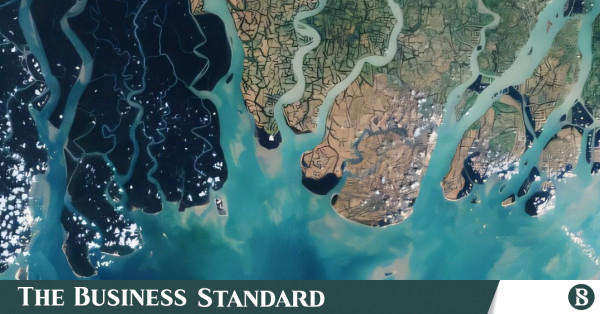As oceans swell and storms intensify, a quiet menace is seeping into coastal lands across the globe: salt.
This creeping salinization of freshwater supplies and fertile soil now threatens the livelihoods of over 500 million people—most acutely in low-lying river deltas where life is intimately tied to the rhythm of water, says Phys.org.
In a new study, scientists from the University of Portsmouth, in collaboration with Dhaka University and Curtin University, reveal the growing reach of saltwater intrusion in the Bengal Delta of Bangladesh—the largest river delta on Earth. Their findings trace how rising sea levels are steadily driving salt into once-fresh rivers and aquifers, altering the delicate balance of this vital ecosystem.
Drawing on nearly two decades of data from more than 50 monitoring stations in coastal Bangladesh, the team tracked a consistent rise in salt levels in rivers and estuaries, particularly since the mid-2000s.
The western parts of the delta, already more prone to tidal influence, showed the fastest increases in salinity. The data suggests that the combination of sea-level rise, reduced freshwater flow, and increasingly frequent storm surges are all contributing to the inland movement and retention of saltwater.
Since about 2007, many parts of the delta have experienced stepwise increases in salinity, often linked to powerful storms like Cyclone Sidr. These changes can devastate crops, erode food security, and force communities to move. While the analysis focused primarily on environmental data, it underscores how salinity intrusion is increasingly a threat to livelihoods, public health, and regional stability.
The study, published in Ecological Indicators, uses one of the most detailed and long-running salinity datasets in any delta system worldwide. It applied advanced statistical methods to distinguish long-term trends from short-term weather or seasonal changes.
The researchers introduced a new conceptual model called the Offshore Controlled Estuarine and Aquifer Nexus (OCEAN) framework, that highlights how offshore features like steep underwater slopes and restricted tidal flows can trap salt in low-lying coastal zones, says Phys.org.
.Dr. Mohammad Hoque from the University of Portsmouth’s School of the Environment and Life Sciences: said, “What we’re seeing in the Bengal Delta is not just a local crisis, it’s a signal of what’s coming for low-lying coastal areas around the world.
“Salinity is rising faster and reaching farther inland than many people realize, and it’s happening quietly with major consequences for water security, agriculture, and livelihoods. This study helps us understand the mechanics behind it, and underscores the urgency for coordinated, global action.”
The findings also show the limits of relying only on land-based solutions. Human interventions like embankments, riverbed alterations, and upstream dams have often made things worse by restricting freshwater flows.
Meanwhile, offshore dynamics—such as sediment build-up and ocean current shifts—play a larger role than previously appreciated. Addressing the problem, therefore, requires integrated approaches that connect rivers, oceans, and climate systems.
Coastal regions in California, including Los Angeles County and the Sacramento-San Joaquin Delta, are combating saltwater intrusion through innovative measures. In LA, freshwater is injected into aquifers to create hydraulic barriers against seawater. However, population growth and groundwater extraction continue to challenge these efforts.
“While the focus is on Bangladesh, the study’s implications are global,” said Dr. Sean Feist, former Ph.D. researcher at the University of Portsmouth and now Scientific Officer at Test Valley Borough Council.
“Coastal regions from the Mekong Delta in Vietnam to Louisiana’s wetlands in the United States face similar pressures. As sea levels continue to rise, the risk of agricultural land turning salty, drinking water becoming undrinkable, and shallow groundwater becoming permanently brackish grows ever more serious.”
The paper recommends that similar long-term investigations into changing salinity levels be conducted in other vulnerable coastal regions around the world, particularly in low-lying deltas facing rising seas, reduced river flows, and increasing storm activity. Short-term datasets can often misrepresent the scale or pace of salinization, while extended records offer a clearer picture of how saltwater intrusion evolves over time, says Phys.org.
.Dr. Ashraf Dewan from Curtin University said, “Ultimately, this study highlights that the creeping salinization of deltas is a slow-moving but deeply disruptive force. Without urgent investment in salt-tolerant agriculture, better water storage, and strategic planning across entire river basins, the disruptive impacts of salinity are likely to intensify.
“The Bengal Delta is on the frontline of climate change, but it is not alone. The patterns observed here are emerging in many of the world’s great coastal regions. What happens next depends on how quickly we respond.”


